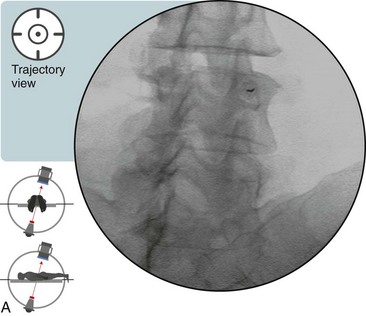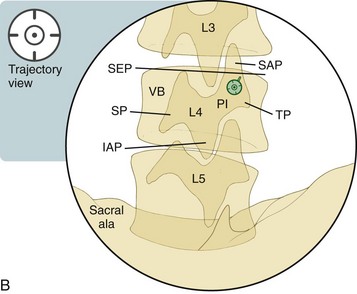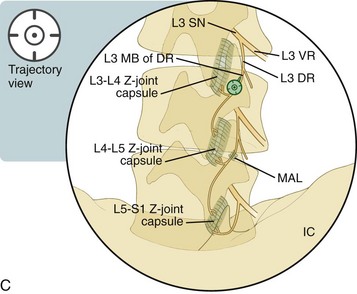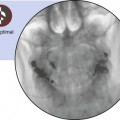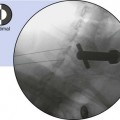Chapter 15 Lumbar Zygapophysial Joint Nerve (Medial Branch) Radiofrequency Neurotomy, Posterior Approach
Note: Please see page ii for a list of anatomical terms/abbreviations used in this book.
The zygapophysial joints (Z-joints) in the spine are diarthrodial joints with synovial linings that are covered with hyaline cartilage. All Z-joints are innervated by two medial nerve branches: one from the posterior ramus above and one at the same segmental level (e.g., the L3 and L4 medial branches innervate the L4-L5 Z-joint). The only caveat is that the L5-S1 Z-joint is innervated by the L4 medial branch and the L5 dorsal ramus. Please see Figure 14–7 for more details regarding the anatomy of these joints.
Lumbar radiofrequency neurotomy is typically performed after significant pain relief is documented with either an intraarticular Z-joint joint injection and/or a medial branch block injection. However, the approach to lumbar radiofrequency neurotomy is different from the approach used in those injections. In addition, no contrast dye is necessary. The probe is positioned to lay parallel and over the medial branch nerve. Because there is anatomic variation of the course of the medial branch nerve, many practitioners perform, at a mininum, two lesions at each site.1
With the approach described here, the needle is placed with the use of a trajectory view and advanced with the use of multiplanar imaging, with an emphasis on safely using the lateral and ipsilateral oblique views to confirm depth. Before neurotomy, sensory and motor stimulation confirms non-radicular stimulation and 0.5 to 1 cc of anesthetic is typically placed. The time and duration of the denervation varies with different practitioners (e.g., up to three 90-second cycles at 80–85° C).1
 Trajectory View
Trajectory View
 Confirm the level (with the anteroposterior view).
Confirm the level (with the anteroposterior view).
 Tilt the C-arm image intensifier to square off the superior end plate (SEP) of the vertebral body (VB) and then tilt the C-arm image intensifier 15 to 20 degrees caudally from the squared SEP.
Tilt the C-arm image intensifier to square off the superior end plate (SEP) of the vertebral body (VB) and then tilt the C-arm image intensifier 15 to 20 degrees caudally from the squared SEP.
 Oblique the C-arm image intensifier 15 degrees toward the symptomatic side (the right side, in this case).
Oblique the C-arm image intensifier 15 degrees toward the symptomatic side (the right side, in this case).
 This angle is used for entry and to approximate the trajectory of the target nerve.
This angle is used for entry and to approximate the trajectory of the target nerve.
 The probe tip destination is the lateral border of the superior articular process (SAP) and the very small concavity that is formed by the junction of the SAP and the transverse process.
The probe tip destination is the lateral border of the superior articular process (SAP) and the very small concavity that is formed by the junction of the SAP and the transverse process.
 At the L5 level, the iliac crest may interfere with needle positioning. If the recommended angle does not allow for proper needle trajectory, the tilt angle may need to be adjusted to optimize the visualization of the target.
At the L5 level, the iliac crest may interfere with needle positioning. If the recommended angle does not allow for proper needle trajectory, the tilt angle may need to be adjusted to optimize the visualization of the target. Because this is the trajectory view, the needle entry position should be parallel to the C-arm beam (Figure 15–1
Because this is the trajectory view, the needle entry position should be parallel to the C-arm beam (Figure 15–1
).

